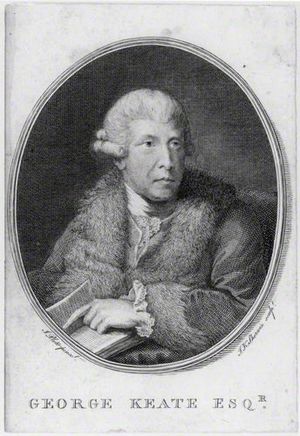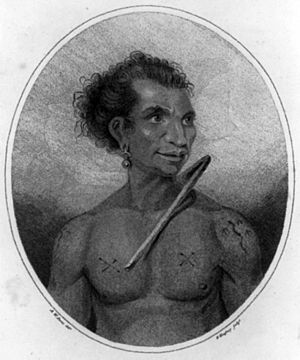George Keate facts for kids
Quick facts for kids
George Keate
|
|
|---|---|

George Keate, 1781 engraving by John Keyse Sherwin, after John Plott
|
|
| Born | 1729 Trowbridge, Wiltshire, England
|
| Died | 1797 (aged 67–68) Bloomsbury, London
|
| Occupation | poet and writer |
George Keate (1729–1797) was an English poet and writer. He was a very talented author who also enjoyed art. Keate traveled a lot and became a friend of the famous French writer Voltaire.
About His Life
George Keate was born in Trowbridge, Wiltshire, England, in 1729. His father was also named George Keate. He went to school in Kingston upon Thames.
After school, Keate trained to be a lawyer. He joined the Inner Temple in 1751 and became a lawyer in 1753. However, he never actually worked as a lawyer.
For several years, Keate lived in other countries, especially in Geneva, Switzerland. There, he met the famous writer Voltaire. In 1755, he was in Rome, Italy.
When he returned to England, Keate started writing. He was interested in many things, including poetry, nature, and history. He was also an artist. Keate helped start the Society of Artists of Great Britain in 1761. Later, he joined the Royal Academy in 1768. He was also chosen to be a member of important groups for history and science, like the Society of Antiquaries of London and the Royal Society, both in 1766.
Other famous writers, like Fanny Burney and Mary Delany, wrote about George Keate. Mary Delany even visited his collection of interesting items in 1779.
George Keate's health got worse in his last years. He died suddenly in London on June 28, 1797. He was buried in Isleworth. A special monument with a bust (a sculpture of his head and shoulders) was made by Joseph Nollekens for his burial place. After he died, his collection of shells was sold. His collection of coins was given to the Bodleian Library.
His Writings and Art
George Keate wrote many different types of works. He was an amateur writer, meaning he wrote for pleasure and not as his main job. Here are some of his notable works:
- Ancient and Modern Rome (1760): This was a poem about Rome.
- Short Account of the Ancient History, present Government and Laws of the Republic of Geneva (1761): This book was about Geneva, where he met Voltaire.
- Epistle from Lady Jane Grey to Lord Guildford Dudley (1762): A poem written as if from Lady Jane Grey.
- The Alps, a Poem (1763): A poem about the famous mountains.
- Netley Abbey, an Elegy (1764): A sad poem about a ruined abbey.
- Ferney; an Epistle to Voltaire (1768): This poem praised Voltaire. Because of this poem, the town of Stratford-upon-Avon gave Keate an ink-stand made from a tree planted by William Shakespeare. They also made him an honorary citizen.
- The Monument in Arcadia (1773): A play inspired by a famous painting.
- Sketches from Nature, taken and coloured in a Journey to Margate (1779): This book was a travel story. It was very popular and was even translated into French.
- Poetical Works (1781): This collection included all his published poems and some new ones.
- The Distressed Poet (1787): This poem described his problems with a long legal case against his architect, Robert Adam.

- Account of the Pelew Islands (1788): This famous book told the story of Captain Henry Wilson and his crew. Their ship, the Antelope, was wrecked on the Palau islands in 1783. The book was based on Wilson's journals. It was reprinted many times and translated into French and German.
Keate also wrote short pieces for a magazine called Archæologia. He also wrote introductions and endings for plays performed at a school in Hackney.
Between 1766 and 1789, Keate showed many of his own paintings. He exhibited six pictures at the Society of Artists and thirty at the Royal Academy. His letters to Voltaire and Edward Young are now kept in the British Library.
His Family
In 1769, George Keate married Jane Catharine Hudson. They had one daughter named Georgiana Jane Keate (1770–1850).
Georgiana was also an artist. She showed four of her paintings at the Society of Artists in 1791. She painted a portrait of Prince Lee Boo from memory. Prince Lee Boo was a young man from the Pelew Islands who visited England. Georgiana's portrait was used in her father's book about the islands.
In 1796, Georgiana married John Henderson. He was also an amateur artist and supported other artists like Thomas Girtin and J. M. W. Turner. Georgiana died in 1850.

